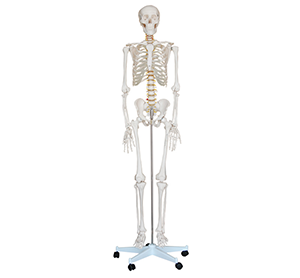The intracavitary injection model has undoubtedly revolutionized medical education by providing a safe, risk-free training platform to help students better master the technology, reduce errors in clinical practice, and accelerate the skill acquisition process. With the continuous progress of technology, the future intracavitary injection model of shoulder joint will be more intelligent and personalized, making medical training more efficient and safe. Taken together, the intracavity shoulder injection model not only provides a safer training environment for medical education, but also plays an important role in improving physician skills and reducing clinical risks.
Is the 180cm human bone model suitable for medical training needs?
With the continuous development of medical education, human skeleton model, as an important teaching tool, plays an important role in anatomy and clinical skills training. Can the 180cm human skeleton model meet the diverse needs of medical training? How well does it work?

1. Anatomical structure conforming to adult standards
The 180cm human skeleton model represents the standard height of an adult male and meets the requirements of adult anatomy in medical training. Most medical courses focus on the study of adult bones, especially in the training of clinical operations such as fractures and joint diseases, and the 180cm model can provide students with more accurate anatomical reference. Through highly simulated bone models, students can better understand the position, shape and interrelationships of various parts of the bone, enhancing hands-on skills and spatial sense.
Data support:
According to market research, 180cm models of the human skeleton occupy a mainstream position in medical schools and clinical training, with about 70% of educational institutions using such models for anatomy and clinical skills training.
II. Adaptable to a wide range of teaching needs
In addition to the standard anatomy teaching, the 180cm human bone model can also be widely used in multiple teaching scenarios such as the display of bone structure, demonstration of joint movement, and surgical operation simulation. The flexibility of the model allows it to adapt to the needs of different medical training, whether it is basic anatomical learning, or complex clinical surgery drills, through this standardized model to provide accurate simulation environment.
Third, market trend: Growing demand
With the transition of medical education to practice-oriented, there is a growing demand for high-quality simulation equipment. The 180cm human skeleton model is an important part of this trend. Market analysis shows that with the continuous deepening of medical courses, especially the cultivation of clinical skills, the demand for bone models continues to rise. The market for human bone models is expected to grow by about 20% in the next few years.
IV. Improve teaching efficiency and quality
Using a 180cm human bone model allows medical students to master bone structure and related operations more quickly. Through repeated practice, students can quickly accumulate experience in a simulated environment and shorten the adaptation period of clinical practice. The data showed that medical courses taught using bone models improved the students' operational accuracy and clinical confidence by more than 25% compared with traditional teaching methods.
Summary:
The 180cm human skeleton model is not only suitable for basic anatomy learning, but also can meet the diversified needs of clinical skills training. Its high degree of imitation, wide range of application scenarios and growing market demand prove the important value of this model in medical education. Through this teaching tool, students are able to accumulate valuable practical experience in a risk-free environment, laying a solid foundation for future clinical work.
